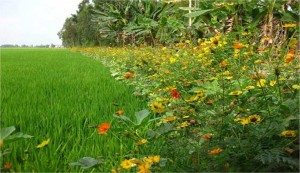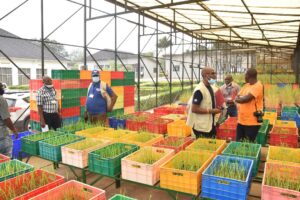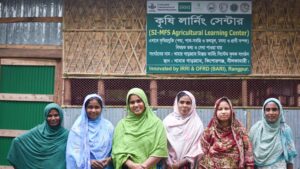
The efforts to manage rice pests such as planthoppers have taken on a simple message: let nature have its way in your fields. In essence, leave the friendlies such as spiders, predatory bugs, and parasitic wasps alone, and you increase rice’s chances against planthopper outbreaks.
As straightforward as the message is, doing away with old-time practices of finding assurance from insecticides is not.
In a statement calling for support on pesticide regulation and for a ban in the use of specific insecticides in rice that contribute to planthopper outbreaks, the International Rice Research Institute (IRRI) has offered alternative practices to better manage pests and has called on its partners to join its concerted efforts to change mindsets.
Asia bears hopper brunt
The message comes as rice losses from planthopper outbreaks spread across Asia. Indonesia’s Western, Central, and Eastern Java lost more than 25,000 hectares of rice to hopperburn and virus diseases in 2010. Planthoppers and associated virus diseases have also intensified in central Thailand, the southern provinces of China, and northern Vietnam.
Between 2009 and 2011, rice production in Thailand suffered huge losses caused by brown planthopper (BPH) and two viral diseases this pest transmits called grassy stunt and ragged stunt. More than 3 million hectares were infested, and more than 1.1 million tons of paddy with an export potential of US$275 million were lost. The infestation continues to cause misery to farmers.
In 2009, a new virus disease transmitted by the white-backed planthopper was detected in Vietnam. Originally discovered in China in 2001, the southern rice black streak dwarf virus had spread into most provinces in the Red River Delta and further south into central Vietnam.
This virus is now endemic in most of China’s southern provinces, namely, Hainan, Guangdong, Guangxi, Yunnan, and Fujian. Planthopper damage costs Chinese rice farmers about 1 million tons of rice annually. However, in 2005, these losses increased to 2.5 million tons.
In 2005, Vietnam lost about 400,000 tons of rice paddy and, as the problem persisted, this prompted the country to suspend its exports in 2007. This was due to attempts to protect the domestic supply, which caused volatility in rice prices as happened in the 2007-08 rice price crisis, prompting warnings from the World Bank that millions would be pushed further down the poverty line.
In 2009, an estimated 300,000 hectares were heavily infested in China and Vietnam, and more than 6,500 hectares suffered a complete crop failure.
Ecosystem breakdown
Planthopper outbreaks are primarily caused by a breakdown of “ecosystem resilience” or biological control functions in the rice landscape.
IRRI entomologist K.L. Heong said that a rice field, left on its own without interference from chemicals, has its own foot soldiers that provide protection from pest outbreaks.
A rice field is a patchwork of rich diversity in which spiders, aquatic bugs, parasitic wasps, and predatory bugs thrive. IRRI offers an option to better manage pests in rice fields by letting nature’s biological foot soldiers do the job of controlling pests. These are called natural enemies―enemies of pests, that is.1
An irrigated rice ecosystem in the Philippines, for example, is home to nearly 700 organisms, most of which are friendly to rice. Each has a role that makes for a delicate balance, making the landscape environmentally sustainable.
“Biodiversity is about balancing the positives and the negatives,” said Dr. Heong. “It is about roles, interactions, and stability.
“Without natural enemies, planthoppers multiply and can overrun a ricefield, causing an outbreak,” he added.
Ineffective pesticide use
Natural enemies keep the pest population in check. The whole system starts to fall off-balance, however, the moment chemicals are sprayed.
Farmers often spray insecticides in the early crop growth period to control leaf feeders, such as the leaf folder. The chemicals used at this time also kill beneficial parasitoids and spiders–natural enemies of hoppers. Such preventive sprays, especially with broad-spectrum insecticides, render rice ecosystems extremely vulnerable to planthopper outbreaks and actually make planthopper outbreaks ten times more likely to occur.
Even when farmers are trying to target planthoppers with their insecticide application, their methods may be ineffective―often applying insecticide on top of the rice canopy where it doesn’t reach the nymphs hiding beneath the canopy, and with poor equipment that delivers large droplets.
Pesticides: consumer good or regulated material?
No amount of solid, environmentally sustainable practice will work, however, if farmers are not weaned from the belief that they need to use chemicals to control pests.
“Effective advertising has led our farmers to believe that they need chemicals to solve their pest problems,” laments Dr. Heong. “Misuse is created by pesticides being marketed as fast-moving consumer goods and farmers relying mainly on village pesticide retailers for advice.”
As consumer goods, pesticides are marketed using emotional appeals and even giveaways, effectively putting reason on the back burner.
Dr. Heong believes that pesticide use must be knowledge-based in order to preserve balance in the rice ecosystem and therefore prevent outbreaks.
In a report published on ricehopper. net, Dr. Heong said, “Insecticide misuse is an important cause of the current planthopper outbreaks in Asia, namely, Thailand, Indonesia, and the Philippines.”
A crucial step against chemicals
Earlier in 2011, Thai scientists reported that huge populations of BPH had infested rice fields in the provinces of Ayutthaya, Chai Nat, Suphan Buri, Ang Thong, Sing Buri, and Pathum Thani, destroying thousands of hectares of areas planted to rice.
In March 2011, the report said, “Damages reported in 11 provinces affected 104,000 hectares, and further hopper outbreaks would seem inevitable. Numerous farms in the northern provinces, like Pitsanuluk, are now heavily infested.”
In June 2011, Thailand’s Minister of Agriculture and Cooperatives Theera Wongsamut announced a $12.8-million initiative to stop the use of two outbreak-causing insecticides— cypermethrin and abamectin—in Thai rice crops to control the BPH outbreaks and to implement a campaign to improve pest management practices in rice. These efforts are supported by both IRRI and the Thai Agro Business Association―Thailand’s pesticide industry association (see IRRI supports Thailand moves to stop insecticide use in rice).
IRRI Director General Robert Zeigler applauded the action of the Rice Department. “It is of international significance that Thailand will undertake this initiative because, as the world’s largest exporter of rice, it is recognized as a global leader in the rice industry,” he said.
Action
In its action plan that seeks to solve the hopper problem sustainably, IRRI has proposed the restoration of biodiversity in rice fields, as well as building ecological resilience.
Specifically, IRRI recommends ecological engineering approaches that introduce landscape elements such as flowers and other plants to promote the buildup and sustenance of a healthy population of natural enemies of planthoppers.
IRRI also recommends the use of resistant varieties, or a combination of varieties, that are tolerant of the local or invading planthopper populations. However, to prevent the hoppers from developing resistance to a variety, farmers are advised against using the same variety for more than 2 years.
Synchronous planting and fallow periods of 1 month in between successive crops of rice, as well as crop diversification schemes, are also included in IRRI recommendations.
To support farmers in their on-ground activities, IRRI is also calling on its partners in national governments and the private sector to regulate the marketing and improve the use of insecticides.
The call is to shift the classification of pesticides away from consumer goods to regulated materials and to ban or restrict the use in rice of broad-spectrum pesticides that contain active ingredients known to contribute to planthopper outbreaks―cypermethrin, deltamethrin, abamectin, and chlorpyrifos.
Certifying and training pesticide retailers is also recommended to prevent sales of fake, banned, or unapproved products, and to foster the promotion of integrated pest management and proper pesticide use.
__________________
Ms. Baroña-Edra is a science communication specialist at IRRI.









